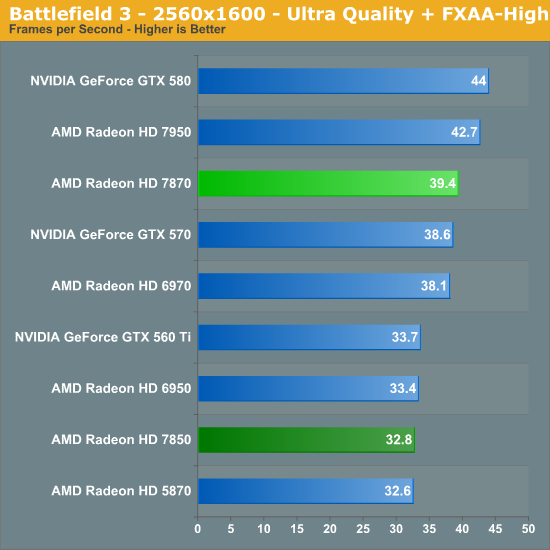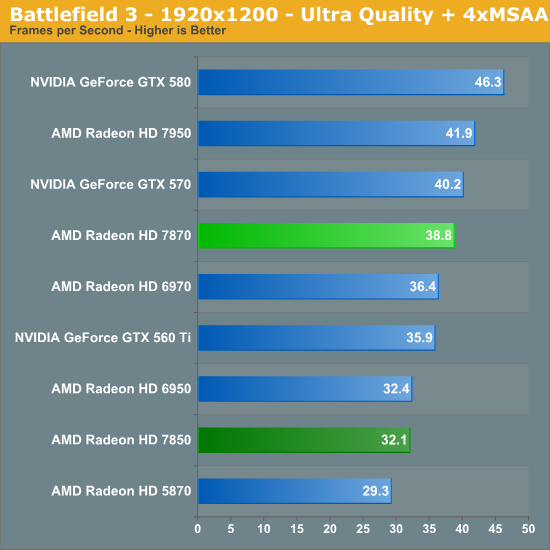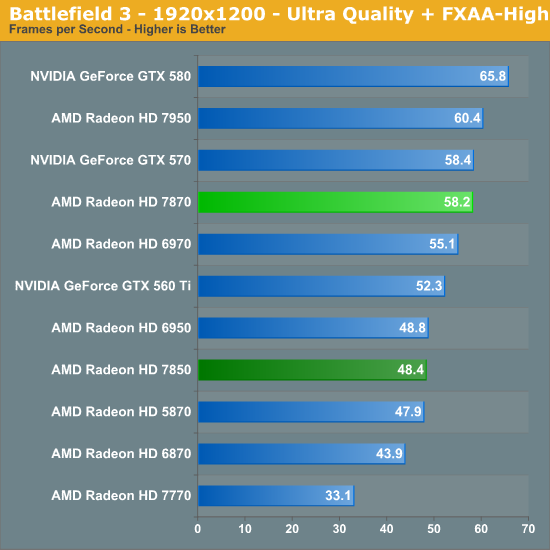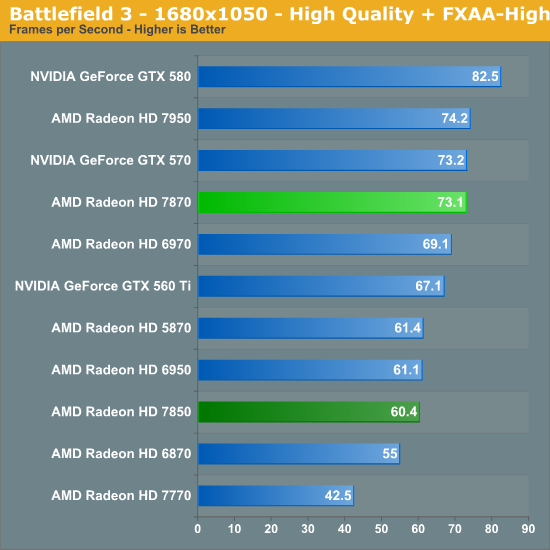AMD Radeon HD 7870 GHz Edition & Radeon HD 7850 Review: Rounding Out Southern Islands
by Ryan Smith on March 5, 2012 12:01 AM ESTBattlefield 3
Its popularity aside, Battlefield 3 may be the most interesting game in our benchmark suite for a single reason: it’s the first AAA DX10+ game. It’s been 5 years since the launch of the first DX10 GPUs, and 3 whole process node shrinks later we’re finally to the point where games are using DX10’s functionality as a baseline rather than an addition. Not surprisingly BF3 is one of the best looking games in our suite, but as with past Battlefield games that beauty comes with a high performance cost




For anyone keeping score, we reran all of our numbers after the recent Battlefield 3 Radeon HD 7000 series performance patch. The results are virtually identical. While we don’t have official confirmation, we believe that DICE switched to a different FXAA codepath; however doing this doesn’t seem to have impacted the performance of the 7000 series, which is either a testament to AMD’s shader compiler, or proof that the overhead from FXAA is very low in the first place.
In any case while AMD’s BF3 performance has improved since the 7970 launch, it’s still one of their weaker games. The 7870 can hang with the GTX 570 at 1920 but the 7850 once more falls behind the GTX 560 Ti. The 7850 in particular just isn’t doing very well here, and it would be necessary to drop down in settings or in resolution to get fluid gameplay out of BF3. However at the same time we do see some further evidence of the impact of having 2GB of VRAM, as both 7800 cards improve relative to NVIDIA’s cards at 2560.
Meanwhile compared to the 6900 series, the 7800 series takes another small lead. At 19x12 without MSAA the 7870 has 5% on the 6970, while the 7850 is effectively tied with the 6950. It’s interesting to note however that relative to the 7950, the 7870 is doing very well here, trailing AMD’s faster card by less than 4%. The fact of the matter is that with the same basic frontend and the same number of ROPs, the 7870’s 1GHz core clock can significantly eat into the performance lead of the 7950 if the 7950 is primarily performance bound by either of those two rendering stages.










173 Comments
View All Comments
chizow - Monday, March 5, 2012 - link
Sorry, fact checking 101 says the 7850 is still clearly behind the 570, about 10% faster than the GTX 560Ti ($200). The 7870 may be the SKU you're referring to but it costs $350, which again, brings very little movement on pricing:performance relative to 14-16 month old parts.CeriseCogburn - Thursday, March 8, 2012 - link
Hey don't be so factual. medi01 can also look forward to blurred up MLAA, lack of LOD detail compensation, no PhysX, drivers crashing like mad inexplicably for a year or two until things get "ironed out", new games "not running", mouse cursors stuck in corners, whining about tessellation levels in games "it can't handle", and generally blaming nvidia for all it's failures...The "$80" imaginary dollars he saves he can "reinvest" in a "solid" with a "for sure" payoff - his endless hours "fixing" his 7850 "issues".
SlyNine - Monday, March 5, 2012 - link
That's a very 1 dimensional opinion. Compared to the 5870 node change which equaled 2x performance for around the same price, A fab shrink that doesn't double your performance for the money is disappointing.We are comparing it to how past node changes changed the price/performance model. This one is HORRIBLE because it basically slides right in to the old one, so now we have a node change that does very little for price.
I'm running a 5870 which is basically 75% the performance of a 7970, and I paid 379 for the 5870. Which is also 75% of the cost of a 7970. The price of a 7970 is basically the exact same price structure as the 2 1/2 year old 5870, So we are stuck where we were in 2009, yay.
morfinx - Monday, March 5, 2012 - link
75% performance of 7970 would mean that it's 33% faster than a 5870. And that's just not accurate. I have a 5870 as well, so I was paying a lot of attention on how much faster the 7970 is in various reviews. Everything I've read indicates that it's anywhere from 70-110% faster at 2560x1600 resolution (I run 3600x1920, so likely even even more of a difference). That's not even even considering the massive overclocking headroom of the 7970 vs barely any OC headroom of the 5870. Overclocked, a 7970 is easily twice as fast as a 5870.SlyNine - Thursday, March 8, 2012 - link
I should have said 66% for 66% of the price. Point being the price/Performance has not improved...Its around 40-60% faster according to Anandtech's benchmarks.
Overclocked, don't make me laugh.
chizow - Monday, March 5, 2012 - link
@Kiste: Agreed, don't worry about the criticism you're taking. This site has a lot of readers with very low standards or very limited perspective when it comes to the GPU industry.7000 series pricing and performance is a disappointment so far, there's no doubt about it. You can throw as much historical perspective and factual pricing/performance at them but you''ll just be greeted with blank stares and accusations of fanboyism.
Bottomline is this, if Nvidia follows this price and performance structure, EVERYONE would be disappointed.
If Nvidia took 14-16 months and only improved their entire product stack 15-25% on a new architecture and new process node with Kepler while increasing prices accordingly, it'd be a colossal failure.
It makes you wonder why the AMD fans don't see it the same way?
Kaboose - Monday, March 5, 2012 - link
you're acting like Kepler has been released and Nvidia won't be doing the same exact thing, I really doubt we will see Nvidia releasing higher performing cards then AMD at much lower prices like you see to think.chizow - Monday, March 5, 2012 - link
I didn't say we know what Kepler holds, what I'm saying is *IF* Nvidia did this, it would be a colossal failure and we could just write off 28nm entirely. That's why it makes you wonder why AMD fans are giving them a pass for such little improvement in performance and pricing.Honestly, with 15-25% improvement top to bottom over existing SKUs, Nvidia could have simply refreshed their entire Fermi line-up and hit those targets with just clockspeed increases from the smaller process.
At no other point in the history of GPUs has a new process/architecture from either IHV brought so little movement in price and performance. There's no innovation here and no incentive for anyone who bought in the last few generations to bother upgrading.
If you have a 5850/470 or better, there is VERY little reason to upgrade right now especially at the asking prices.
Kaboose - Monday, March 5, 2012 - link
What % of people have 5850/470 or better GPUs though? Im going to say not many. 7850/7870 are good cards for people entering the market on mid range desktops that want to add a GPU for gaming. As well as HTPC use. And for system builders who are looking for a good OC and current gen. technology.Ananke - Monday, March 5, 2012 - link
See Steam statistics. The 5th series was the majority. The largest target market are owners of 5850/5870. I have 5850 and I can afford any card, but I see no reason to upgrade. At this price point gaming is not the only usage, I want quality hardware video encoding acceleration by MANY software packages, GPGPU applications. Today, in those areas, AMD has actually even less applications than when they launched the 5th series.For SO much money and NO applications outside gaming the ONLY reason not to use NVidia would be heat dissipation. If Kepler cards are colder, NVidia has a win.